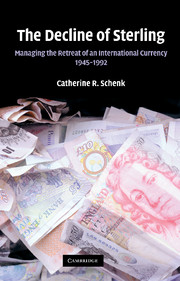1 - Introduction
Published online by Cambridge University Press: 04 May 2010
Summary
The role of sterling and the management (or mismanagement) of its retreat from an international to a national currency has been a central issue in the post-war history of the United Kingdom. Politically as well as economically, sterling's international role has helped to define Britain's place in the world. From the earliest days of post-war western European integration, sterling's place in the global international monetary system distinguished Britain from other European countries. In terms of the ‘special relationship’ with the United States, the international status of sterling alongside the US dollar created a forum for Anglo-American cooperation and an opportunity for the United Kingdom to exercise strategic influence. In Commonwealth relations, the problems of sterling were an important shared concern that defined the economic dimension of the new Commonwealth and the British Empire after the war. Given Britain's greatly reduced position in the international economy after 1945 and its relatively poor economic performance in the following decades, however, supporting an international currency seemed to many critics to pose an unacceptable burden. In this context, why was sterling's international role as a reserve currency and a commercial currency prolonged for so long? The literature notes that there is considerable inertia in the use of international currencies, but this is not easily explained. Network externalities may delay switching from a currency used by a wide group of traders and states, and this would suggest that a tipping point will arise at some point that will lead to a rapid transformation, but what will prompt this event?
- Type
- Chapter
- Information
- The Decline of SterlingManaging the Retreat of an International Currency, 1945–1992, pp. 1 - 34Publisher: Cambridge University PressPrint publication year: 2010

